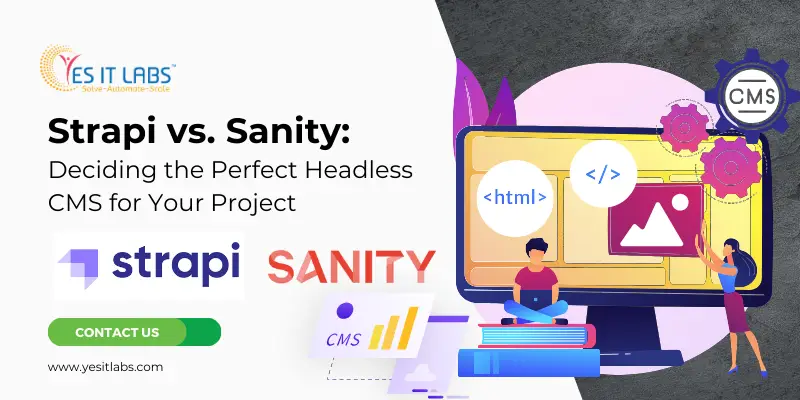
 By Admin
By Admin Strapi vs. Sanity: Deciding the Perfect Headless CMS for Your Project
In the dynamic world of web development, choosing the right Headless CMS (Content Management System) is crucial for a seamless and efficient content creation and management process. Among the myriad of options available, Strapi vs Sanity.io have emerged as strong contenders. In this blog post, we’ll explore the key features of both Strapi and Sanity, highlight their differences, and help you make an informed decision for your project.
Strapi vs. Sanity.io: The Showdown
1. Which is better – Strapi or Sanity.io?
The answer to this question depends on your project requirements and your team’s preferences. Both Strapi and Sanity.io are powerful, but they cater to different needs.
Strapi: Empowering Developers with Flexibility
Strapi is an open-source Headless CMS that has gained popularity for its flexibility and developer-friendly approach. Built on Node.js, Strapi allows developers to create custom APIs quickly, making it an excellent choice for projects that demand a high level of customization. With a user-friendly admin panel, Strapi enables non-technical users to manage content effortlessly.
Sanity.io: Real-time Collaboration and Structured Content
On the other hand, Sanity.io is known for its real-time collaboration features and structured content approach. It offers a robust content modeling system, making it ideal for projects with complex data structures. Sanity.io’s real-time collaboration features are particularly beneficial for teams working on content simultaneously.
Consider Strapi if you prioritize customization and want a more straightforward development process. Opt for Sanity.io if real-time collaboration and structured content are essential for your project.
2. Key Features of Strapi and Sanity.io
Key Features of Strapi:
- Open-Source Nature: Strapi is free and open-source, allowing developers to modify and extend it according to their project’s needs.
- Customizable API: Strapi’s API is highly customizable, enabling developers to define and implement their data structures and endpoints.
- User-Friendly Admin Panel: Strapi offers an intuitive admin panel that makes it easy for non-technical users to manage content without relying on developers.
- Plugins and Extensions: The Strapi ecosystem includes a variety of plugins and extensions, providing additional functionalities and integrations.
Key Features of Sanity.io:
- Real-Time Collaboration: One of Sanity.io’s standout features is its real-time collaboration capabilities, facilitating seamless teamwork.
- Structured Content Modeling: Sanity.io allows developers to define structured content models, ensuring a standardized approach to content creation.
- Developer-Friendly CLI: Sanity.io provides a command-line interface (CLI) that empowers developers with efficient tools for managing projects.
- Image and Asset Management: Sanity.io excels in handling images and assets, making it an excellent choice for projects with rich media content.
3. Difference between Strapi vs Sanity.io
Data Modeling and Structure:
- Strapi: Developers have the freedom to create and define custom data structures through a visual interface, allowing for a flexible content model.
- Sanity.io: Employs a schema-based approach, where developers define the structure of their content through a schema definition language. This ensures a more standardized and structured data model.
Content Editing Experience:
- Strapi: Offers a user-friendly admin panel that allows both technical and non-technical users to manage content efficiently.
- Sanity.io: Prioritizes real-time collaboration, offering a customizable and developer-friendly interface. The collaborative features enhance the content editing experience for teams.
Technology Stack:
- Strapi: Built on Node.js, Strapi’s technology stack makes it well-suited for projects that require a JavaScript-centric environment.
- Sanity.io: Utilizes a combination of JavaScript, React.js, and other technologies. Its focus on a structured content approach makes it suitable for projects with diverse technical requirements.
Community and Ecosystem:
- Strapi: With a large and active community, Strapi boasts an extensive ecosystem of plugins and extensions that enhance its functionalities.
- Sanity.io: While not as extensive as Strapi, Sanity.io’s community is growing rapidly, and its ecosystem is gaining traction.
Conclusion: Choosing the Right Fit
In the Strapi vs. Sanity.io showdown, there is no one-size-fits-all answer. Your choice should align with your project’s specific needs, team expertise, and preferences.
If you value flexibility, customization, and an extensive plugin ecosystem, Strapi might be your go-to choice. On the other hand, if structured content modeling, real-time collaboration, and efficient image management are critical for your project, Sanity.io could be the perfect fit.
Before making your decision, consider the scale, complexity, and nature of your project. Both Strapi and Sanity.io have proven themselves in the realm of Headless CMS, offering unique strengths that cater to different use cases. Ultimately, the right choice is the one that aligns with your project’s goals and your team’s workflow.
Latest Resources
Transforming Your Shopify Store with Node.js App Development
April 30, 2024
Xamarin Trailblazers: Pioneering the Future of Mobile Apps
April 29, 2024






















 Services
Services


